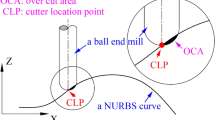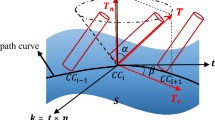Abstract
A novel cutter radius compensation method named cutting-point virtual tool radius compensation (CPVTRC) is presented in the finishing of ellipsoidal outer contour. CPVTRC, which corresponds to a virtual tool established at cutting point, is realized through parametric programming which is powerful in solving special manufacturing problems and exhibits great industrial application prospect. The parametric program for ellipsoidal outer contour finishing is given based on the algorithm of CPVTRC. The corresponding amount of the virtual tool radius per layer is calculated via the cutting-point coordinates and the elliptical outer offset curve parametric equation of the current layer. And it is inputted into corresponding registers online using programmable data input command G10L12, and then called through cutter compensation command G41/G42 before interpolation of the ellipse in the current layer. Consequently, the ellipse per layer of ellipsoid is approached via tiny line segments using CPVTRC method. The results of simulation based on VERICUT software and experiment based on a 3-axis vertical computer numerical control (CNC) machine equipped with FANUC 0i-MC exhibit that CPVTRC is highly effective and correct. Furthermore, CPVTRC can extend its application to the CNC parametric programming and machining of swept surfaces.
Similar content being viewed by others
References
Lee YS, Koc B (1998) Ellipse-offset approach and inclined zig-zag method for multi-axis roughing of ruled surface pockets. Comput-Aided Des 30:957–971
Redonnet JM, Rubio W, Monies F, Dessein G (2000) Optimising tool positioning for end-mill machining of free-form surfaces on 5-axis machines for both semi-finishing and finishing. Int J Adv Manuf Techno 16:383–391
de Oliveira AJ, Diniz AE (2009) Tool life and tool wear in the semi-finish milling of inclined surfaces. J Mater Process Tech 209:5448–5455
HOU M, FADDIS TN (2006) Automatic tool path generation of a feature-based CAD/CAPP/CAM integrated system. Int J Comput Integ m 19–4:350–358
Chen SL, Wang WT (2001) Computer aided manufacturing technologies for centrifugal compressor impellers. J Mater Process Tech 115–3:284–293
FanWG YPQ, Zhang H, Fang CX, Wang RC (2013) Using rotary contact method for 5-axis convex sculptured surfaces machining. Int J Adv Manuf Techno 67:2875–2884
Farouki RT, Li SQ (2013) Optimal tool orientation control for 5-axis CNC milling with ball-end cutters. Comput Aided Geom D 30:226–239
FANUC (2001) FANUC Series 16/18i-MB operator’s manual
SIEMENS (2006) SINUMERJK 840D sl/840Disl/840D/840Di/8IOD program manual
Liu ZQ (2001) Methodology of parametric programming for error compensation on CNC centers. Int J Adv Manuf Technol 17:570–574
Djassemi M (2000) An efficient CNC programming approach based on group technology. J Manuf Syst 19:213–217
McMahon CA, Sims LK, Williams JH, Webber G (1992) Observations on the application and development of parametric-programming techniques. Comput-Aided Des 24:541–546
Smid P (2006) CNC programming techniques: an insider’s guide to effective methods and applications. Industrial Press Inc, New York
Smid P (2010) CNC control setup for milling and turning: mastering CNC control systems. Industrial Press Inc, New York
Smid P (2004) Fanuc CNC custom macros: programming resources for fanuc custom macros B users. Industrial Press Inc, New York
Sinha SK (2010) CNC programming using Fanuc Custom Macro B. McGraw-Hill Professional, New York
Han L, Gao XS, Li HB (2013) Space cutter radius compensation method for free form surface end milling. Int J Adv Manuf Techno 67:2563–2575
Moreton DN, Durnford R (1999) Three- dimensional tool compensation for a three-axis turning centre. Int J Adv Manuf Techno 15–9:649–665
Hong H, Yu D, Zhang L, Han L (2009) Research on 3D cutter radius compensation for 5-axis end milling. J China Mech Eng 15:1770–1774
Gao JG, Wang H, Huang CB, Liu XW (2010) A new cutter offset algorithm is applied in the milling emulation. J Manuf Automation 2:150–153
Chen YD, Wei HX, Wang TM (2011) Three-dimensional tool radius compensation for a 5-axis peripheral milling. J Advanced Sci Lett 4(8–10):3093–3096
Xu Q, Wang YZ (2007) Study on the post processing of space radius compensation. J Modular Mach Tool Autom Manuf Tech 8:14–16
Terai H, Asao T, Mizugaki Y (2009) Geometric simulation of ball end milling and application for the precise machining. Int J Mach Mach Mater 6:83–94
Liu K, Wu H, Liu PL, Shaw KC (2011) Ultra-precision machining of aluminium alloy surfaces for optical applications. Int J Nanomanuf 7:116–125
Chen XB, Li WL, Xiong YL (2011) A manifold approach to generating iso-scallop trajectories in three-axis machining. Sci China Technol Sci 54:131–139
Wang GP, Sun JG (2001) Shape control of swept surface with profiles. Comput-Aided Des 33:893–902
Coquillart S (1987) A control-point-based sweeping technique. IEEE CG/A 11:36–45
Akman V (1992) Sweeping with all graphical ingredient in a topological picture book. Comput Graph 16(3):273–281
Author information
Authors and Affiliations
Corresponding author
Rights and permissions
About this article
Cite this article
Wang, Z., Wang, X. The principle and application of cutting-point virtual tool radius compensation for ellipsoidal outer contour finishing using a ball end mill. Int J Adv Manuf Technol 71, 1527–1537 (2014). https://doi.org/10.1007/s00170-013-5577-6
Received:
Accepted:
Published:
Issue Date:
DOI: https://doi.org/10.1007/s00170-013-5577-6




